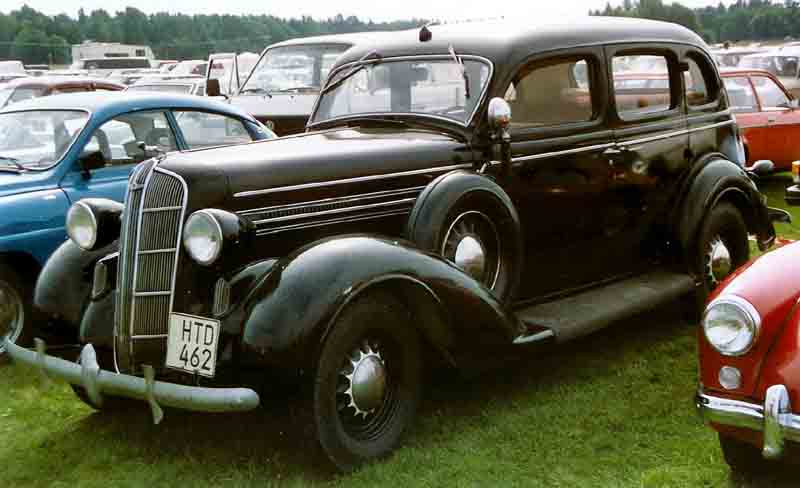Dodge Series D5 on:
[Wikipedia]
[Google]
[Amazon]
The Dodge Series D5 appeared in October 1936 for the 1937 model year, replacing the previous year's Series D2 (also known as the "Dodge Beauty Winner").
 The D5 did not differ particularly from its predecessor, continuing to use the same flathead
The D5 did not differ particularly from its predecessor, continuing to use the same flathead
File:1937 Dodge Series D5 2-door Touring Sedan, front left.jpg, Dodge D5 2-door Touring Sedan
File:1937 Dodge D6 (33239097004).jpg, 1937 Dodge D6 four-door sedan (export model)
File:1937 Dodge Coupe.jpg, Rear view of the D5 Business Coupe
Series D5
 The D5 did not differ particularly from its predecessor, continuing to use the same flathead
The D5 did not differ particularly from its predecessor, continuing to use the same flathead straight-six engine
The straight-six engine (also referred to as an inline-six engine; abbreviated I6 or L6) is a piston engine with six cylinders arranged in a straight line along the crankshaft. A straight-six engine has perfect primary and secondary engine bala ...
, single-disc dry-plate clutch, and three-speed manual transmission. A vacuum-operated semi-automatic system was an available option. The body was lightly facelifted, with a modified split grille, larger headlamps, and with the horns moved behind the grille rather than being mounted conspicuously on the fender aprons. Lee, p. 257 A chrome strip continued the length of the car. On the inside, the dashboard had recessed knobs and flush-fitting gauges, as well as safety padding on the front seatbacks and "no-snag" interior door handles. The hypoid rear axle was also new and meant a lower transmission tunnel as well as a flat floor at the rear of the car.
Most D5's sat on the shorter wheelbase (one inch shorter than in 1936); only the seven-seater Limousine, five-seater Pullman-Limousine, the five-seater Victoria-Convertible models, and the naked chassis used the longer version. The standard bodyworks were two- and four-door sedans, available as "Fastbacks" or "Touring" sedans, with Touring versions receiving an enclosed luggage compartment. There were two 2-door coupes, the two-seater "Business Coupe" and the "Rumble-Seat Coupe," which had two inside seats and two more in the rumble seat
A rumble seat (American English), dicky (dickie/dickey) seat (British English), also called a mother-in-law seat, is an upholstered exterior seat which folded into the rear of a coach, carriage, or early motorcar. Depending on its configuration, ...
. Convertible versions included the 2-door "Convertible Coupe" and the 4-door "Convertible Sedan."
In October 1937, the D5 was replaced by the Series D8, while the Junior line models (for export and the Canadian market) were badged D9 and D10 for 1938. 295,047 Dodge D5s were built in the calendar year.
A modified copy of the D5's engine was produced under liecense in the Soviet Union
The Soviet Union,. officially the Union of Soviet Socialist Republics. (USSR),. was a transcontinental country that spanned much of Eurasia from 1922 to 1991. A flagship communist state, it was nominally a federal union of fifteen national ...
by GAZ
GAZ or Gorkovsky Avtomobilny Zavod (russian: ąōąÉąŚ or ąōąŠ╠üčĆčīą║ąŠą▓čüą║ąĖą╣ ą░ą▓č鹊ą╝ąŠą▒ąĖ╠üą╗čīąĮčŗą╣ ąĘą░ą▓ąŠ╠üą┤, , Gorky Automobile Plant) is a Russian automotive manufacturer located in Nizhny Novgorod, formerly known as Gorky (ąōąŠč ...
during the 1940s-1950s and was fitted in the manufacturer's GAZ-M20 Pobeda
The GAZ-M20 "Pobeda" (russian: ąōąÉąŚ-ą£20 ą¤ąŠą▒ąĄą┤ą░; ''ą┐ąŠą▒ąĄą┤ą░'' means ''victory'') was a passenger car produced in the Soviet Union by GAZ from 1946 until 1958. It was also licensed to the Polish Passenger Automobile Factory and produce ...
alongside the GAZ-51
The GAZ-51 (nickname ''Gazon'') was a Soviet truck manufactured by GAZ. Its first prototypes were produced before the end of World War II and has been influenced by Studebaker US6. The mass production started in 1946.
A 2.5 ton 4├Ś2 standard vari ...
truck.
Dodge Juniors
The so-called Junior line used the Plymouth's chassis, body, and engine, with the grille and other trim parts from Dodge's Senior line. The basic business version (D6) was built in Canada as well as in Detroit, while the deluxe D7 was only built in Canada. The American-made D6s were made for overseas markets and were also available in right-hand drive. Their equipment and bodystyles correspond to Plymouths's P3 and P4 models from the same year, although the wheelbase is somewhat longer than that of the Plymouth's. Lee, pp. 372-373 Both series were available as a two-door Business Coupe, and as two- or four-door Touring Sedans. The D6 also offered trunkless versions of the sedans while the D7 was available as a Rumble-Seat Coupe. D6s as well as the D7s received Plymouth's smaller version of Chrysler's flathead engine, producing at 3600 rpm. 39 of the D6s built in Detroit received a narrow-bore export engine displacing to suit local tax designations, developing 19.8RAC horsepower
Horsepower (hp) is a unit of measurement of power, or the rate at which work is done, usually in reference to the output of engines or motors. There are many different standards and types of horsepower. Two common definitions used today are the ...
rather than the larger engine's 23.4 RAC hp. Just over 7,000 D6s were built in Detroit, while 10,888 D6 and D7 were built in Canada, of which over 8,000 were D7s.
References
External links
{{Dodge D5 Full-size vehicles Cars introduced in 1936